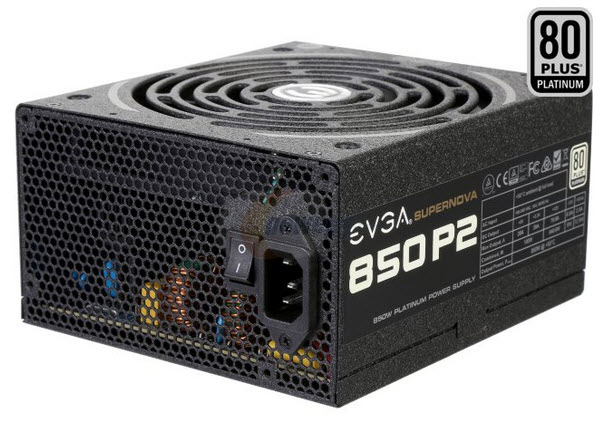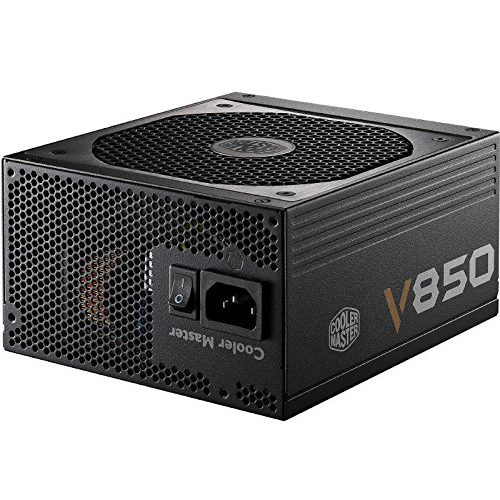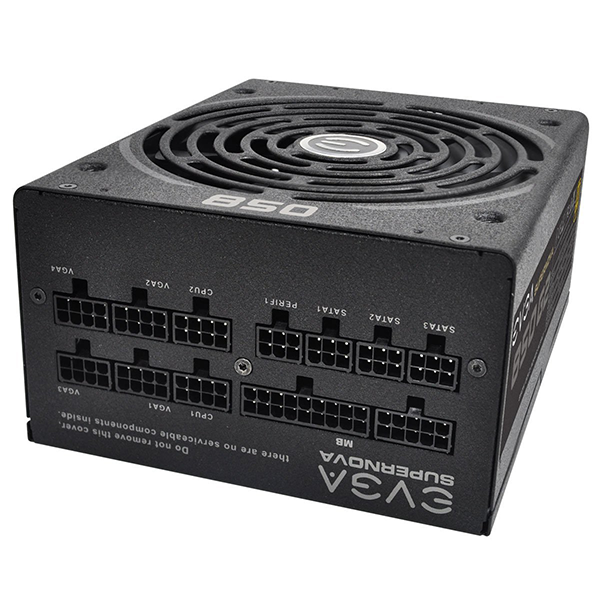EVGA SuperNOVA 850 P2 Power Supply Review
EVGA recently enriched its P2 line with three new members, featuring 650W, 750W and 850W capacities. All three, like the other P2 models, are made by Super Flower and feature Platinum efficiency. Today we're testing the 850 P2.
Load Regulation, Hold-Up Time And Inrush Current
To learn more about our PSU tests and methodology, please check out How We Test Power Supply Units.
Primary Rails And 5VSB Load Regulation
Load Regulation testing is detailed here.
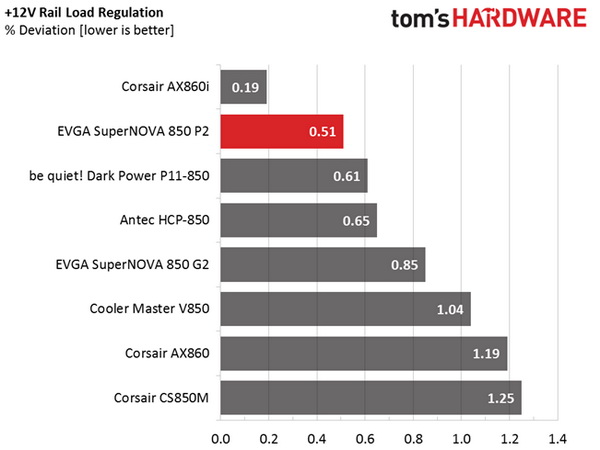
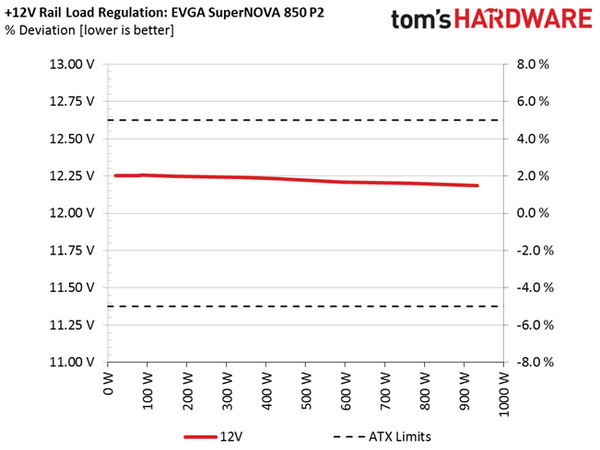
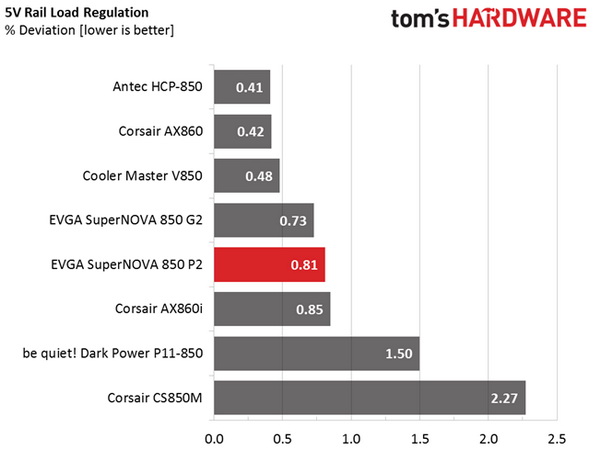
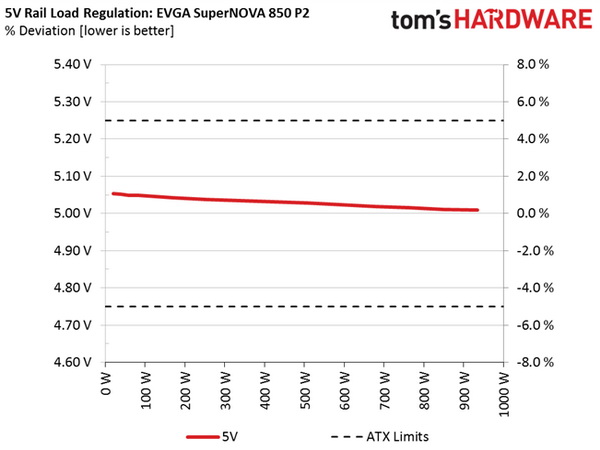
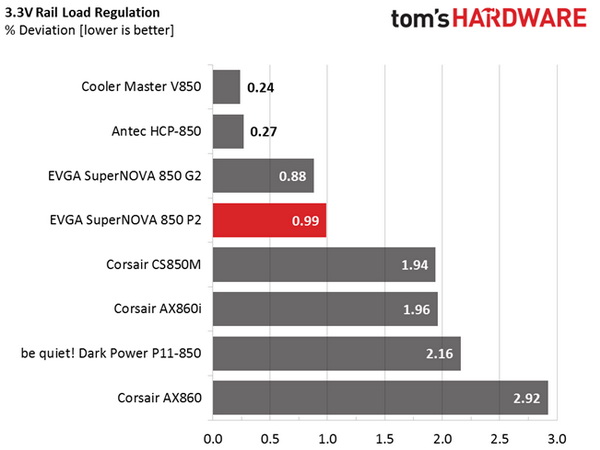
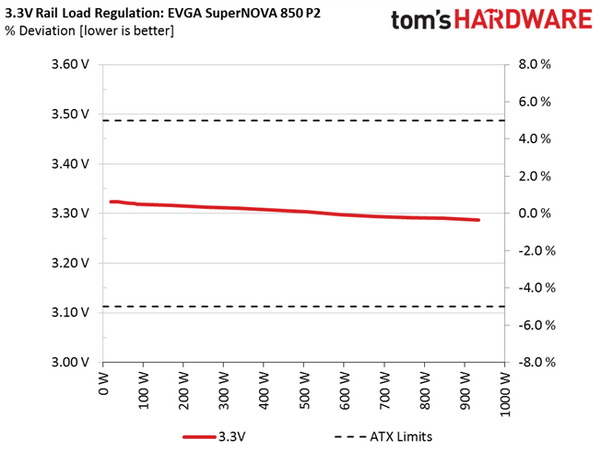
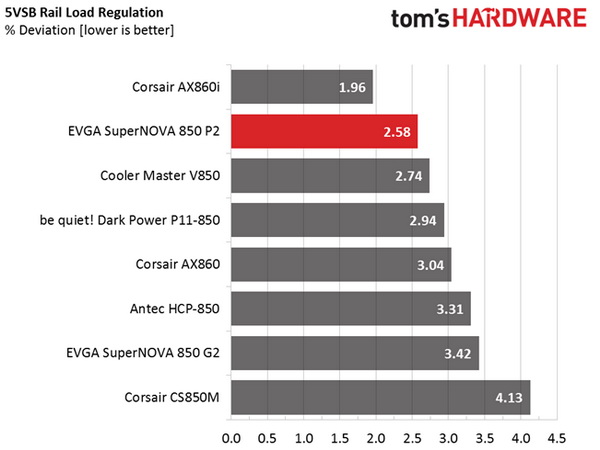
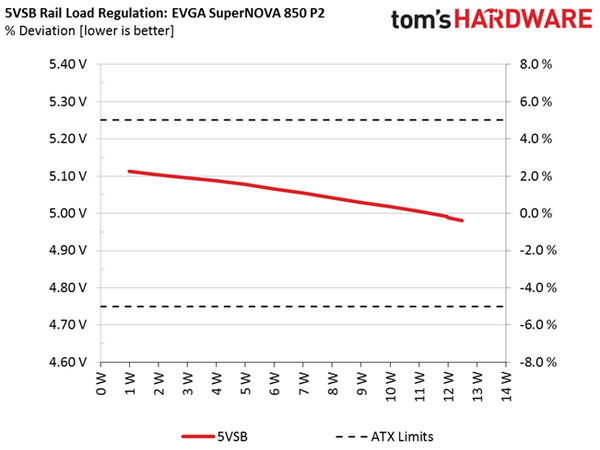
Hold-Up Time
Our hold-up time tests are described in detail here.
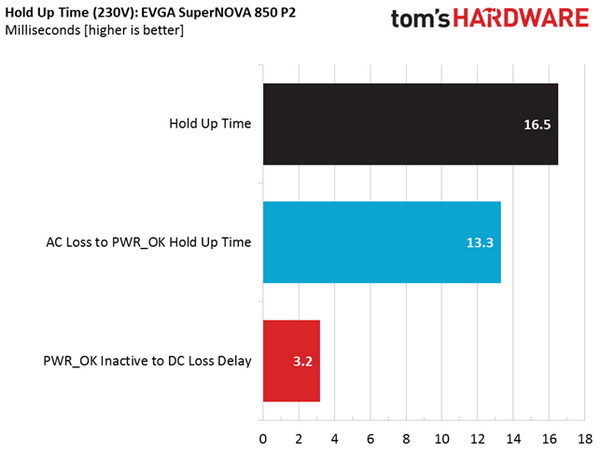
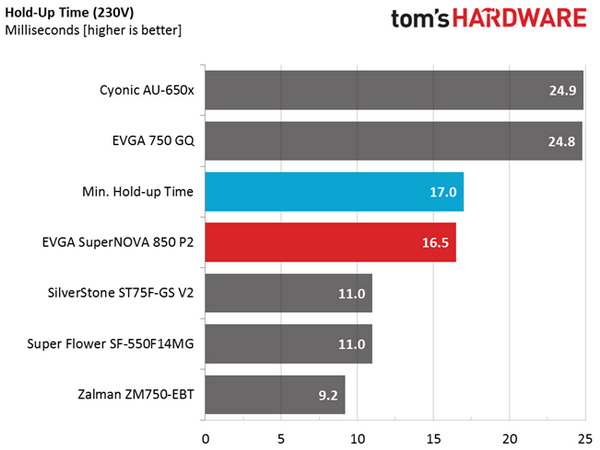
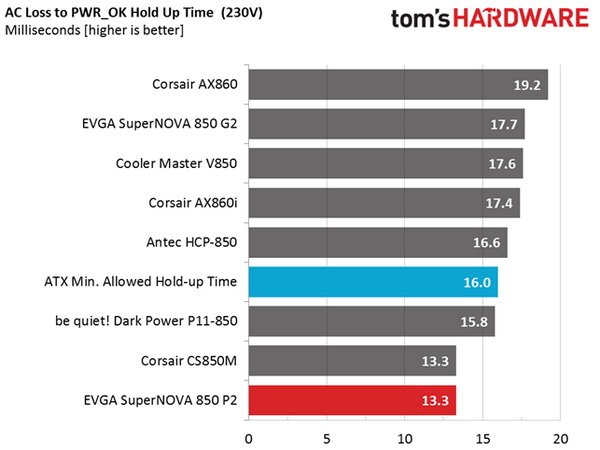
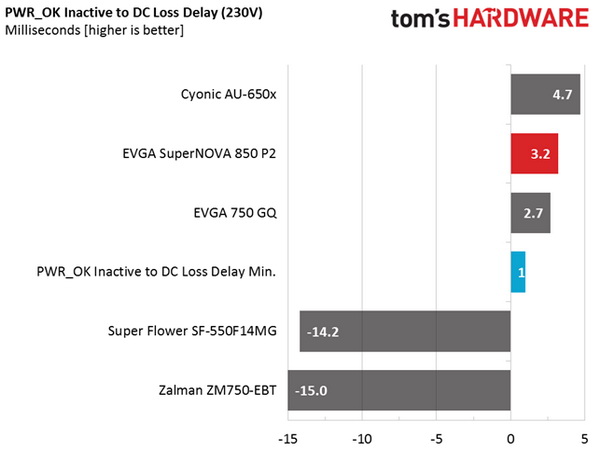
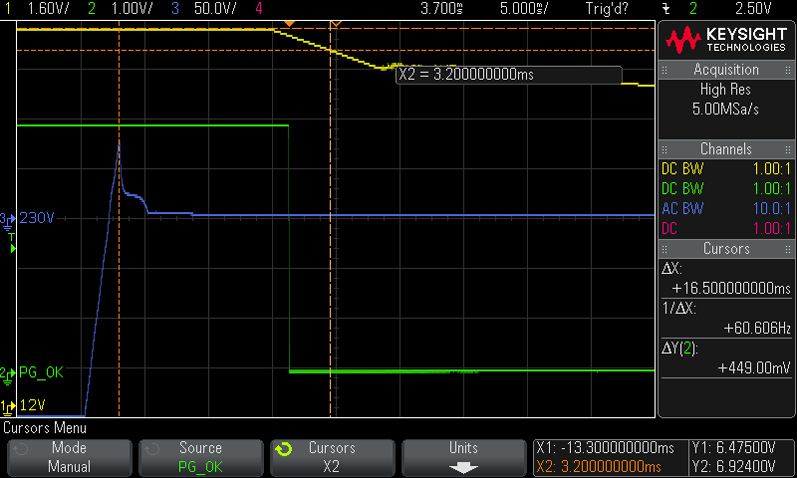
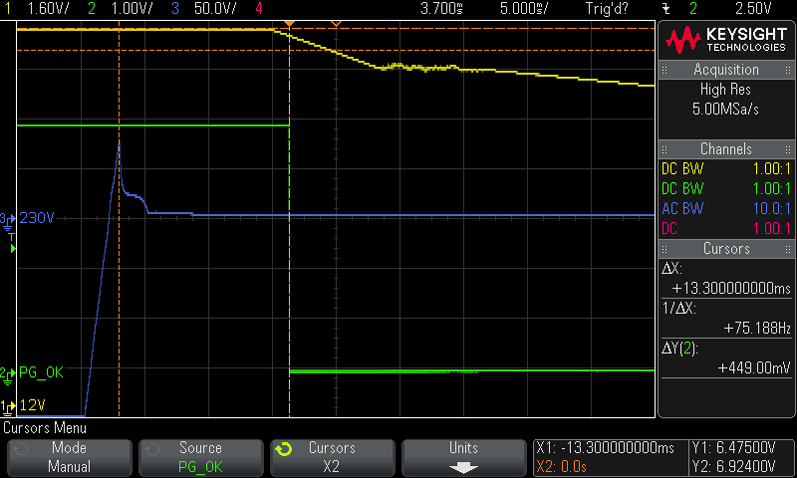
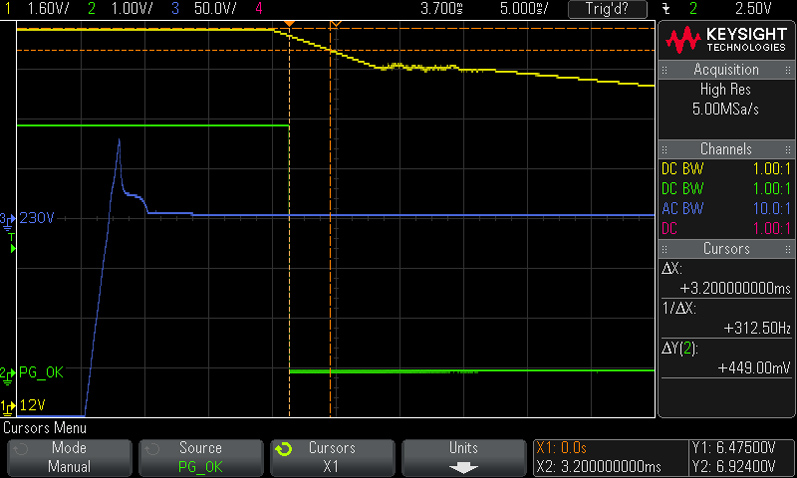
The measured hold-up time is only 0.5ms lower than the minimum allowed. However, the power-good signal's hold-up time is 2.7ms less than 16ms, which is what the ATX spec requires. In other words, the PSU fails here. The only silver lining is that the power-good signal drops well before the rails go out of spec.
Inrush Current
For details on our inrush current testing, please click here.
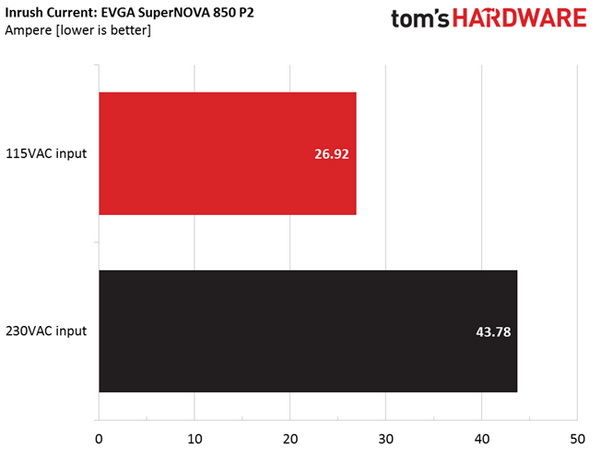
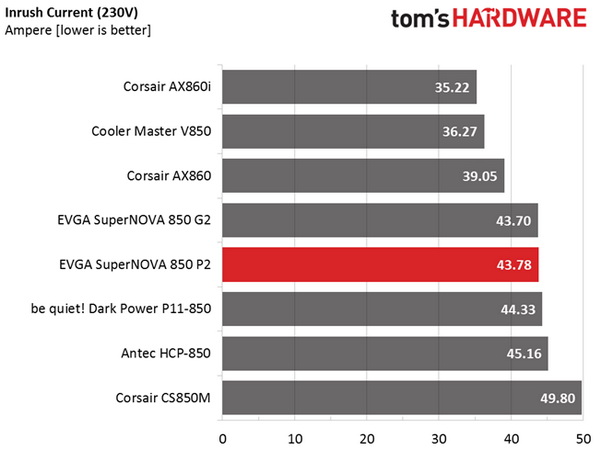
The inrush current is at normal levels for a PSU with 850W capacity.
Load Regulation And Efficiency Measurements
The first set of tests explores voltage rail stability and efficiency. The applied load equals (approximately) 10 to 110 percent of the supply's maximum in increments of 10 percentage points.
Get Tom's Hardware's best news and in-depth reviews, straight to your inbox.
We conducted two additional tests. During the first, we stressed the two minor rails (5V and 3.3V) with a high load, while the load at +12V was only 0.10A. This test reveals whether a PSU is Haswell-ready or not. In the second test, we determined the maximum load the +12V rail could handle with minimal load on the minor rails.
| Test # | 12V | 5V | 3.3V | 5VSB | DC/AC (Watts) | Efficiency | Fan Speed (RPM) | Noise (dB[A]) | Temps (In/Out) | PF/AC Volts |
|---|---|---|---|---|---|---|---|---|---|---|
| 1 | 5.155A | 1.985A | 1.985A | 0.979A | 84.75 | 86.63% | 0 | 0 | 48.53 °C | 0.936 |
| 12.255V | 5.048V | 3.319V | 5.078V | 97.83 | 41.77 °C | 115.1V | ||||
| 2 | 11.329A | 2.968A | 2.984A | 1.181A | 169.61 | 90.36% | 0 | 0 | 52.03 °C | 0.967 |
| 12.249V | 5.042V | 3.316V | 5.065V | 187.71 | 44.84 °C | 115.1V | ||||
| 3 | 17.871A | 3.475A | 3.499A | 1.384A | 254.91 | 91.39% | 0 | 0 | 55.33 °C | 0.982 |
| 12.244V | 5.038V | 3.313V | 5.054V | 278.93 | 47.71 °C | 115.1V | ||||
| 4 | 24.394A | 3.973A | 3.983A | 1.585A | 339.74 | 91.64% | 0 | 0 | 58.71 °C | 0.986 |
| 12.239V | 5.034V | 3.311V | 5.042V | 370.75 | 50.71 °C | 115.1V | ||||
| 5 | 30.591A | 4.968A | 4.989A | 1.785A | 424.66 | 91.44% | 920 | 35.9 | 41.51 °C | 0.990 |
| 12.232V | 5.031V | 3.307V | 5.029V | 464.43 | 48.31 °C | 115.1V | ||||
| 6 | 36.816A | 5.964A | 5.995A | 1.990A | 509.63 | 91.13% | 920 | 35.9 | 41.76 °C | 0.992 |
| 12.219V | 5.028V | 3.303V | 5.018V | 559.26 | 48.90 °C | 115.1V | ||||
| 7 | 43.034A | 6.971A | 7.002A | 2.195A | 594.58 | 90.66% | 920 | 35.9 | 42.82 °C | 0.994 |
| 12.211V | 5.023V | 3.298V | 5.005V | 655.82 | 50.19 °C | 115.1V | ||||
| 8 | 49.249A | 7.969A | 8.013A | 2.400A | 679.55 | 90.12% | 920 | 35.9 | 44.02 °C | 0.994 |
| 12.207V | 5.018V | 3.294V | 4.992V | 754.08 | 52.47 °C | 115.1V | ||||
| 9 | 55.893A | 8.475A | 8.532A | 2.404A | 764.53 | 89.52% | 1370 | 46.3 | 45.64 °C | 0.995 |
| 12.201V | 5.015V | 3.292V | 4.988V | 854.05 | 54.45 °C | 115.1V | ||||
| 10 | 62.506A | 8.983A | 9.027A | 2.506A | 849.33 | 88.82% | 1840 | 52.3 | 46.97 °C | 0.996 |
| 12.193V | 5.011V | 3.290V | 4.981V | 956.26 | 56.22 °C | 115.1V | ||||
| 11 | 69.505A | 8.989A | 9.036A | 2.509A | 934.27 | 88.14% | 1840 | 52.3 | 48.68 °C | 0.996 |
| 12.187V | 5.009V | 3.287V | 4.977V | 1059.95 | 58.27 °C | 115.1V | ||||
| CL1 | 0.098A | 12.009A | 12.005A | 0.004A | 101.19 | 82.67% | 920 | 35.9 | 44.85 °C | 0.951 |
| 12.272V | 5.024V | 3.301V | 5.100V | 122.40 | 50.97 °C | 115.1V | ||||
| CL2 | 70.789A | 1.002A | 1.003A | 1.002A | 875.83 | 89.36% | 1840 | 52.3 | 47.74 °C | 0.996 |
| 12.183V | 5.025V | 3.304V | 5.051V | 980.09 | 56.80 °C | 115.1V |
Load regulation is very tight on all rails, taking the lead from many PSUs in this competitive category. Moreover, the PSU operates passively at up to the 40 percent load test, generating zero noise. The fan kicks in at 50 percent, but spins slowly, creating minimal acoustic output. We had to dial in 90 percent of this PSU's max-rated load to make the fan spin faster, and only under a full load does the fan spin as fast as it can. At that point, noise output is around 52.3 dB(A).
With 20 percent load, the 850 P2 clears the 80 Plus Platinum requirement of at least 90 percent efficiency. But it's 0.56 percent shy of doing this with 50 percent load. Under full load, it doesn't reach the 89 percent goal (but it's really close). We'll remind you, though, that the 80 Plus organization tests at a much lower ambient temperature, so we expect to see lower efficiency across our suite. The higher the operating temperature of a PSU, the greater the impact on efficiency.
Current page: Load Regulation, Hold-Up Time And Inrush Current
Prev Page A Look Inside And Component Analysis Next Page Efficiency, Temperature And Noise
Aris Mpitziopoulos is a contributing editor at Tom's Hardware, covering PSUs.
-
JQB45 ReplyWhy can't US use 220v, man so much more efficient.
Tradition... There is nothing (I believe) stopping you from running a 220v circuit. I know we have one 20amp NEMA circuit in this house specificity for the computer room. Its not common to see those in house holds either. -
cliffro Reply17550218 said:Tier-1 but on the low end of Tier-1 due to its hold up time.
Scores a 9.7 on Jonnyguru, but is low end of tier 1 got it.
I like Tom's in general, been coming here since Tom was actually doing reviews, but I'll take JonnyGuru's(or Oklahoma Wolf) word that this is an awesome PSU, it scored 10 of 10's in all but Value, where a couple of similar quality PSU were a tad cheaper.
I've got the G2 model(thanks to their review of it) and couldn't be happier with it. Well other than they now have Platinum and Titanium versions and would prefer one of those. But 80+ Gold is still good enough for me. -
powernod Reply17550218 said:Tier-1 but on the low end of Tier-1 due to its hold up time.
Scores a 9.7 on Jonnyguru, but is low end of tier 1 got it.
I like Tom's in general, been coming here since Tom was actually doing reviews, but I'll take JonnyGuru's(or Oklahoma Wolf) word that this is an awesome PSU, it scored 10 of 10's in all but Value, where a couple of similar quality PSU were a tad cheaper.
I've got the G2 model(thanks to their review of it) and couldn't be happier with it. Well other than they now have Platinum and Titanium versions and would prefer one of those. But 80+ Gold is still good enough for me.
Well, i think that you don't pay that much attention to Jonnyguru.com, as much as you claim.
Look here, at Jonny's tier list, and notice what tier is the EVGA's P2 line :
http://www.jonnyguru.com/forums/showthread.php?t=12947
-
dstarr3 ReplyWhy can't US use 220v, man so much more efficient.
The same reason so many regions have different plug types. They all designed these things before anyone had the idea to standardize these things across regions, and by now it's an incredible amount of work to have to redesign the infrastructure of entire countries. -
Adhmuz ReplyWhy can't US use 220v, man so much more efficient.
"Technology, current at the time of US electrification, locked the US into 110, then 120 volt outlets. Europe's electrification came later, and proceeded in response to advanced technology. The US was too deep into the 110/120 volt infrastructure to upgrade."
Gotta hand it to the Americans for inventing the concept of the grid and power distribution to the masses, they did it first, and Edison's equipment at the time ran best on 110v so it was the obvious choice. Currently it's at 120v, this was changed in the 50s. Don't forget houses are supplied with 240v, this is what runs our hot water heaters, ovens and air conditioners. Just the old way is still too set in stone to be changed, not to mention 120v is safer for human exposure (a shock from a 120v outlet is much less dangerous than that of a 240v outlet, having experienced the 120v shock I can't imagine how painful a 240v would be) -
10tacle Reply17552491 said:Just the old way is still too set in stone to be changed, not to mention 120v is safer for human exposure (a shock from a 120v outlet is much less dangerous than that of a 240v outlet, having experienced the 120v shock I can't imagine how painful a 240v would be)
Yep...I was popped by a 220v 3-prong washing machine plug wire that arced some two decades ago (when it was still known as a 220v power connection) and it knocked me on my butt. It makes getting hit by 120v (used to be 110v), which I've also experienced more recently, seem like carpet static electricity.
-
cliffro Reply17552081 said:17550218 said:Tier-1 but on the low end of Tier-1 due to its hold up time.
Scores a 9.7 on Jonnyguru, but is low end of tier 1 got it.
I like Tom's in general, been coming here since Tom was actually doing reviews, but I'll take JonnyGuru's(or Oklahoma Wolf) word that this is an awesome PSU, it scored 10 of 10's in all but Value, where a couple of similar quality PSU were a tad cheaper.
I've got the G2 model(thanks to their review of it) and couldn't be happier with it. Well other than they now have Platinum and Titanium versions and would prefer one of those. But 80+ Gold is still good enough for me.
Well, i think that you don't pay that much attention to Jonnyguru.com, as much as you claim.
Look here, at Jonny's tier list, and notice what tier is the EVGA's P2 line :
http://www.jonnyguru.com/forums/showthread.php?t=12947
This is the summary for my EVGA 850 G2 (Tier 2 according to his list, a WIP according to the post)
Performance
It scores a 9.9 of 10, and is somehow a Tier 2 according to that list. I have no clue as to what he is doing with his list on the forums. I cannot explain HOW a unit that scores 9.9 of 10 is anything less than Tier 1. There are some Corsair units that scored perfect 10's that are also listed as Tier 2 on it as well.
10
Functionality
10
Value
10
Build Quality
9.5
Total Score
9.9
Summary
Buy one. Do I really need to say anything else at this point? Once again, EVGA has something awesome here the competition can't seem to touch price wise. Performance? There are better units, yes. Not very many, but they exist. The real story here is how EVGA keeps managing to offer this kind of performance and still be more affordable than nearly everything else out there, and they have pretty much found perhaps the only OEM on Earth capable of doing it for them. It's got to be real nice being EVGA right now.
The Good:
outstanding ripple suppression
excellent voltage regulation
fully modular
semi-fanless mode
nice blacked out cablingThe Bad:
nothing at all
The Mediocre:
reviewing awesome units is getting dull... where's that gutless wonder in my pile? Second in line? Well, at least I'm guaranteed something interesting in all the wrong ways in a couple weeks...
If it's scoring that close to 10, or an actual 10 (his highest score), it's a Tier 1 to me. And I'd never second guess buying one regardless of brand. -
Amdlova you guys cry like a baby. i use 227v on the computer no ground. with a multimeter can see about 45v on chassis its nice to touch it. i use a ps3 power supply to drive a 400w car amplifier and the psu barely get warm, no fan only passive cooler. 127v as no good use anymore on non days.Reply
